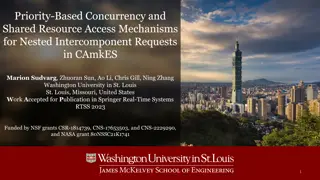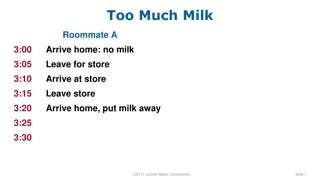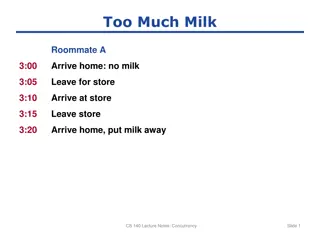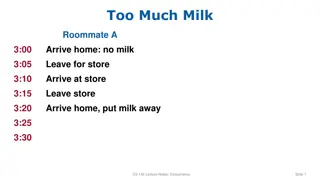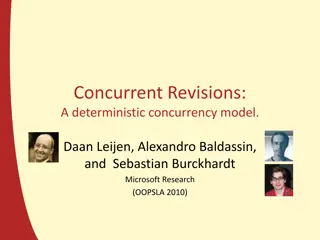
Concurrency vs. Parallelism in Programming
Explore the differences between concurrency and parallelism in programming, where concurrency involves running multiple threads on a shared resource while parallelism focuses on simultaneous execution on separate CPUs. Learn how to utilize multiple workers effectively and the advantages of using threads in modern operating systems.
Uploaded on | 3 Views
Download Presentation

Please find below an Image/Link to download the presentation.
The content on the website is provided AS IS for your information and personal use only. It may not be sold, licensed, or shared on other websites without obtaining consent from the author. If you encounter any issues during the download, it is possible that the publisher has removed the file from their server.
You are allowed to download the files provided on this website for personal or commercial use, subject to the condition that they are used lawfully. All files are the property of their respective owners.
The content on the website is provided AS IS for your information and personal use only. It may not be sold, licensed, or shared on other websites without obtaining consent from the author.
E N D
Presentation Transcript
Lecture Participation Poll #28 Log onto pollev.com/cse374 Or Text CSE374 to 22333 Lecture 28: Concurrency Continued CSE 374: Intermediate Programming Concepts and Tools 1
Administrivia HW 5 (final HW) posted Final review assignment posted! End of quarter due date Wednesday December 16 End of quarter due date Wednesday December 16th th @ 9pm @ 9pm CSE 374 AU 20 - KASEY CHAMPION 2
Concurrency vs Parallelism parallelism parallelism refers to running things simultaneously on separate Separate CPUs) concurrency concurrency refers to running multiple threads on a shared Concurrency is one person cooking multiple dishes at the same time. Parallelism is having multiple people (possibly cooking the same dish). Allows processes to run in the background separate resources (ex. shared resources Responsiveness allow GUI to respond while computation happens CPU utilization allow CPU to compute while waiting (waiting for data, for input) isolation keep threads separate so errors in one don t affect the others CSE 374 AU 20 - KASEY CHAMPION 3
Concurrency Use multiple workers -As a query arrives, create a new worker to handle it -The worker reads the query from the network, issues read requests against files, assembles results and writes to the network -The worker uses blocking I/O; the worker alternates between consuming CPU cycles and blocking on I/O A search engine could run concurrently: -Example: Execute queries one at a time, but issue I/O requests against different files/disks simultaneously -Could read from several index files at once, processing the I/O results as they arrive -Example: Web server could execute multiple queries at the same time -While one is waiting for I/O, another can be executing on the CPU -The OS context switches between workers -While one is blocked on I/O, another can use the CPU -Multiple workers I/O requests can be issued at once -So what should we use for our workers ? CSE 374 AU 20 - KASEY CHAMPION 4
Threads In most modern OS s threads are the unit of scheduling. - Separate the concept of a process from the thread of execution - Threads are contained within a process - Usually called a thread, this is a sequential execution stream within a process Cohabit the same address space - Threads within a process see the same heap and globals and can communicate with each other through variables and memory - Each thread has its own stack - But, they can interfere with each other need synchronization for shared resources Advantages: - They execute concurrently like processes - You (mostly) write sequential-looking code - Threads can run in parallel if you have multiple CPUs/cores Disadvantages: - If threads share data, you need locks or other synchronization - Very bug-prone and difficult to debug - Threads can introduce overhead - Lock contention, context switch overhead, and other issues - Need language support for threads A Process has a unique: address space, OS resources, and security attributes A Thread has a unique: stack, stack pointer, program counter, and registers Threads are the unit of scheduling and processes are their containers; every process has at least one thread running in it CSE 374 AU 20 - KASEY CHAMPION 5
Address Spaces Before creating a thread - One thread of execution running in the address space - One PC, stack, SP - That main thread invokes a function to create a new thread - -> > pthread_create pthread_create() () - -> > After creating a thread - Two threads of execution running in the address space - Original thread (parent) and new thread (child) - New stack created for child thread - Child thread has its own values of the PC and SP - Both threads share the other segments (code, heap, globals) - They can cooperatively modify shared data Single threaded address space Multi-threaded address space CSE 374 AU 20 - KASEY CHAMPION 6
POSIX Threads and Pthread functions The POSIX APIs for dealing with threads - Declared in pthread.h - Not part of the C/C++ language (cf. Java) - To enable support for multithreading, must include -pthread flag when compiling and linking with gcc command -POSIX stands for Portable Operating System Interface, pthread conforms to POSIX standard for threading gcc g Wall std=c11 pthread o main main.c Example Usage - pthread_t thread ID; - the threadID keeps track of to which thread we are referring - pthread_create takes a function plinter and arguments to trigger separate thread - int pthread_create(pthread_t *thread, const pthread_attr_t *attr, void *(*start routing) (void*), void *arg); - note pthread_create takes two generic (untyped) pointers - interprets the first as a function pointer and the second as an argument pointer - int pthread_join(pthread_t thread, void **value_ptr); - puts calling thread on hold until thread completes useful for waiting to thread to exit https://pubs.opengroup.org/onlinepubs/7908799/xsh/pthread.h.html CSE 374 AU 20 - KASEY CHAMPION 7
Creating and Terminating Threads int pthread_create( pthread_t* thread, const pthread_attr_t* attr, void* (*start_routine)(void*), void* arg); - Creates a new thread into *thread, with attributes *attr (NULL means default attributes) - Returns 0 0 on success and an error number on error (can check against error constants) - The new thread runs start_routine start_routine(arg) void pthread_exit(void* retval); - Equivalent of exit - The thread will automatically exit once it returns from start_routine exit(retval); for a thread instead of a process start_routine() CSE 374 AU 20 - KASEY CHAMPION 8
Multi Threaded Example void do_one_thing(int *pnum_times) { int i, j, x; for (i = 0; i < 4; i++) { printf("doing one thing\n"); for (j = 0; j < 10000; j++) x = x + i; (*pnum_times)++; } } #include <stdio.h> #include <pthread.h> void do_another_thing(int *pnum_times) { int i, j, x; for (i = 0; i < 4; i++) { printf("doing another \n"); for (j = 0; j < 10000; j++) x = x + i; (*pnum_times)++; } } void do_one_thing(int *); void do_another_thing(int *); void do_wrap_up(int, int); int main() { pthread_t thread1, thread2; int r1 = 0, r2 = 0; pthread_create(&thread1, NULL, (void *) do_one_thing, (void *) &r1); pthread_create(&thread2, NULL, (void *) do_another_thing, (void *) &r2); pthread_join(thread1, NULL); pthread_join(thread2, NULL); void do_wrap_up(int one_times, int another_times) { int total; total = one_times + another_times; printf("All done, one thing %d, another %d for a total of %d\n", one_times, another_times, total); } do_wrap_up(r1, r2); } CSE 374 AU 20 - KASEY CHAMPION 9
Parallel Processing common pattern for expensive computations (such as data processing) 1. split up the work, give each piece to a thread (fork) 2. wait until all are done, then combine answers (join) to avoid bottlenecks, each thread should have about the same about of work performance will always be less than perfect speedup what about when all threads need access to the same mutable memory? CSE 374 AU 20 - KASEY CHAMPION 10
After forking threads int pthread_join(pthread_t thread, void** retval); - Waits for the thread specified by thread to terminate - The thread equivalent of waitpid waitpid() - The exit status of the terminated thread is placed in *retval int pthread_detach(pthread_t thread); - Mark thread specified by thread as detached it will clean up its resources as soon as it terminates CSE 374 AU 20 - KASEY CHAMPION 11
Race Conditions A race condition race condition happens when the result of a computation depends upon scheduling of multiple threads, ie the order in which the processor executes instructions. Bad Bad interleavings interleavings is when the code exposes bad intermediate state. -example: the getBalance() -> setBalance() calls exposed intermediate state. -Bad interleavings are incorrect from the programmatic logical perspective: -in the bank example, we lost money or allowed balances to go below 0. Data races Data races - - Even if we can't have a line-by-line interleaving, we can still have race conditions -what seems like an "atomic" operation, like setting "balance_ = amount" or "return balance_", is actually NOT guaranteed to be an atomic operation at the compiled machine-code level. whenever you have the potential to read+write or write+write on different threads, you MUST synchronize access to the shared memory (with a lock or similar). CSE 374 AU 20 - KASEY CHAMPION 12
Data Races Two memory accesses form a data race if different threads access the same location, and at least one is a write, and they occur one after another - Means that the result of a program can vary depending on chance (which thread ran first?) Data races might interfere in painful, non-obvious ways, depending on the specifics of the data structure Example: two threads try to read from and write to the same shared memory location - Could get correct answer - Could accidentally read old value - One thread s work could get lost Example: two threads try to push an item onto the head of the linked list at the same time - Could get correct answer - Could get different ordering of items - Could break the data structure! CSE 374 AU 20 - KASEY CHAMPION 13
A Data Race two threads are running at the same time, and therefore, because we cannot guarantee the exact speed at which each thread runs, we could get into a bad situation have a bank account x with a balance of $150 thread T1 calls x.withdrawal(100) and thread T2 calls x.withdrawal(100) right afterwards - two transactions are attempting to happen on the same account - what SHOULD happen is that one of the transactions succeeds in withdrawing 100, and the other throws an exception because the remaining balance of $50 is insufficient T1 reads the balance (150) and stores it in variable b T2 executes completely, deducting 100 from the account to leave a balance of 50 rest of the function on T1 executes, comparing 150 with 100 (ok) and then setting the balance to $50 We've lost a transaction! CSE 374 AU 20 - KASEY CHAMPION 14 https://courses.cs.washington.edu/courses/cse374/18sp/lectures/24-concurrency-1.html
Synchronization Synchronization Synchronization is the act of preventing two (or more) concurrently running threads from interfering with each other when operating on shared data - Need some mechanism to coordinate the threads - Let me go first, then you can go - Many different coordination mechanisms have been invented Goals of synchronization: - Liveness Liveness ability to execute in a timely manner (informally, something good happens ) - Safety Safety avoid unintended interactions with shared data structures (informally, nothing bad happens ) CSE 374 AU 20 - KASEY CHAMPION 15
Lock Synchronization Use a Lock to grant access to a critical section so that only one thread can operate there at a time - Executed in an uninterruptible -an operation we want to be done all at once -operation must be the right size (atomic unit) - too big program runs sequentially - too small program has data races Lock Acquire - Wait until the lock is free, then take it Lock Release - Release the lock - If other threads are waiting, wake exactly one up to pass lock to // non-critical code loop/idle if locked lock.acquire(); // critical section lock.release(); // non-critical code CSE 374 AU 20 - KASEY CHAMPION 16
Example What if we use a lock on the refrigerator? - Probably overkill what if roommate wanted to get eggs? If your fridge has no milk, then go out and buy some more - What could go wrong? If you live alone: fridge.lock() if (!milk) { buy milk } fridge.unlock() For performance reasons, only put what is necessary in the critical section - Only lock the milk - But lock all steps that must run uninterrupted (i.e. must run as an atomic unit) milk_lock.lock() if (!milk) { buy milk } milk_lock.unlock() If you live with a roommate: CSE 374 AU 20 - KASEY CHAMPION 17
pthreads and Locks Another term for a lock is a mutex ( mutual exclusion ) - pthread.h defines datatype pthread_mutex_t pthread_mutex_init() int pthread_mutex_init(pthread_mutex_t* mutex,const pthread_mutexattr_t* attr); - Initializes a mutex with specified attributes pthread_mutex_lock() - Acquire the lock blocks if already locked pthread_mutex_unlock() - Releases the lock pthread_mutex_destroy() - Uninitializes a mutex clean up when done int pthread_mutex_lock(pthread_mutex_t* mutex); int pthread_mutex_unlock(pthread_mutex_t* mutex); int pthread_mutex_destroy(pthread_mutex_t* mutex); CSE 374 AU 20 - KASEY CHAMPION 18
Synchronization Example https://courses.cs.washington.edu/courses/cse374/20sp/lectures/cppcode/BankAccountThr ead.h https://courses.cs.washington.edu/courses/cse374/20sp/lectures/cppcode/BankAccountThr ead.cpp CSE 374 AU 20 - KASEY CHAMPION 20
Questions CSE 374 AU 20 - KASEY CHAMPION 22

